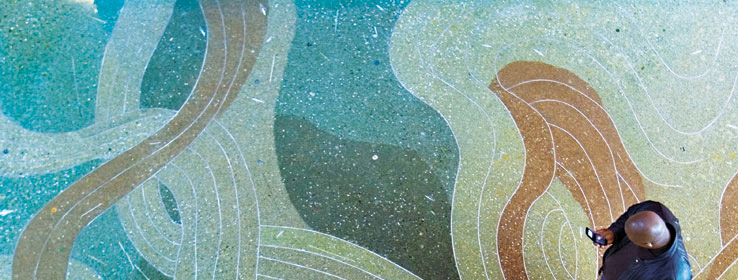An artful and award-winning terrazzo floor illustrates an ancient medium's new design possibilities.
Most of us associate terrazzo floors with the formal, monochromatic designs typically found in courthouses and stately historic homes. Not Linda Beaumont, a Seattle-area artist known for her experimental use of traditional materials.
"I think of terrazzo as a form of painting. And I like to paint outside the lines," she says.
Terrazzo, a mosaic flooring constructed by embedding small pieces of marble and stone in mortar and then grinding and polishing it, is a masonry style that dates back to the ancient Romans. But it's undergoing a reinvention, thanks to innovators like Beaumont.
The artist was commissioned to create a terrazzo design for a 350-foot-long concourse on the ground floor of the recently renovated City Hall in Bellevue, Wash. Inspired by the discovery that an underground river flowed nearby, Beaumont designed "Current": a shimmering, 14,000-square-foot mosaic composed of intricate silver lines, stones, beads and luminescent mother-of-pearl abalone chips.
Color choices
Beaumont needed a color scheme that would suit the scale of the project, the hallway's variations in light intensity and pre-existing materials.
The artist decided on green as the base palette. "The Northwest is all about green," she says. "And 'Current' is a metaphor for a river. It's a public space about possibility. What I really wanted to bring to it was a shimmering, transformative quality. I would never choose one color to define the floor, but rather a relationship of many colors that slide past each other, animating the space."
Beaumont describes 'Current' as a narrative of color. "At the far end of the concourse where there is very little light, I used a deep jade color and dark brown," she says. "It's a 'slower' space. Then, as you walk down the length of the concourse, the floor widens; my idea was that this was the shallow part of the river. There are even beds of silver fish eggs near the conference room. You almost can't see them; from a distance, they just look like pools of light. Under the bridge, in the middle of the concourse, where pedestrian traffic is heavy, there are the wild rapids, the richest part of the floor. The linework is wild and twisting, and I used a lot of color and glitter glass. I had gold and green glitter glass chips made especially for the floor. The iridescent glass is very reflective, especially in dark colors of epoxy, and it shimmers blue and purple and dark green."
The variable color scheme reflects the experience of moving through space. "The thing about working with a floor is that as you walk through, it comes around you in different ways at any given moment," Beaumont says. "The light shifts constantly, so the color changes as well."
For "Current," General Contractor David Franceschina of General Terrazzo used a special two-part thermo-setting epoxy terrazzo matrix (Thin Set Epoxy Terrazzo System #1100) made by General Polymers, a division of Sherwin-Williams. "Epoxy terrazzo has become the norm instead of traditional cement," explains Franceschina.
"It's simpler and quicker to deal with, and is relatively lightweight, which helps when you're installing in modern buildings." And epoxy terrazzo, he says, "offers a vast color palette as opposed to traditional cement, which allows us only earth tones. One of the reasons terrazzo has really been rediscovered over the last 20 years is this new epoxy terrazzo."
Today's flexible new materials freed Beaumont to fully explore her aesthetic: "I like to push everything to be fluid. I'm interested in keeping things moving," she says. "Current" won Job of the Year from the National Terrazzo & Mosaic Association. But the artist is after a more lasting impact: "I really do believe that spaces can change the way we feel and even the way we think," Beaumont says. "When I was a child, I saw those mosaic floors in Greece and Rome and thought, 'Wow! It's as though the earth is being carpeted.' Having that energy underfoot is a beautiful way to feed energy into a public space."
Why use terrazzo?
It's luxurious. Terrazzo creates timelessness and opulence that give any space a unique sense of event. "You're creating from raw material," says David Franceschina, a general contractor with General Terrazzo. "Terrazzo is a handmade product, a piece of art."
It's cost-effective. Originally invented by Roman builders as a low-cost flooring material, terrazzo is a highly durable floor treatment. "Maintenance is very inexpensive," says Linda Beaumont, a Seattle-based artist who works with terrazzo. "And it looks better with age."
It's green. Terrazzo requires only water and neutral liquid cleaner for maintenance. "It's a sustainable product," says Franceschina. "And there's recycled content–old marble and glass. Those elements are very intriguing to architects and building owners."







